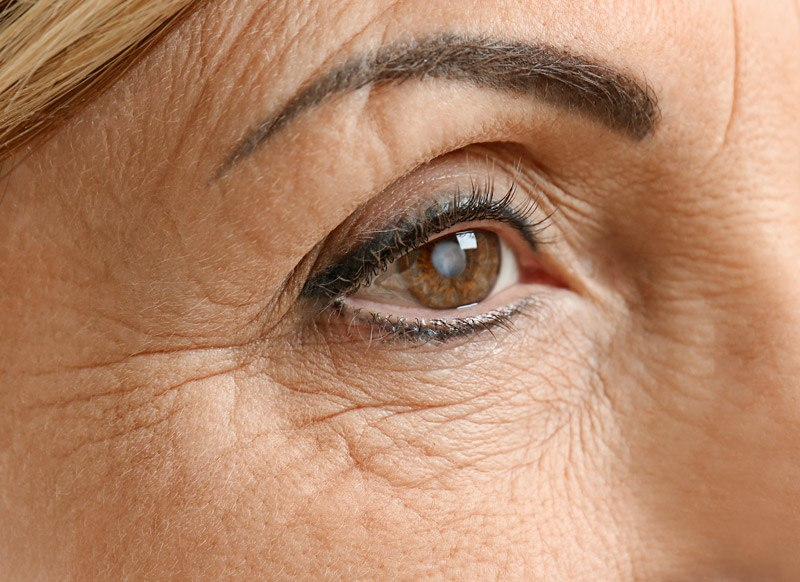A cataract is a progressive and painless clouding effect of our eye’s natural lens. The lens is responsible for focusing the light which enters your eye and delivering clear images. As we age, this lens begins to cloud due to the breakdown and clumping of proteins found within it.
Though it may be painless, a cataract is not harmless – the clouding of the lens blocks and distorts light entering the eye and will eventually lead to total blindness.
Though there is no decisive proof that cataract development can be prevented, there are a number of smart lifestyle choices and procedure options available in order to effectively slow the onset of and treat cataracts.
1. What are Common Cataract Symptoms?
Symptoms of cataracts may be difficult to notice early on but over time will eventually begin to impact your eyesight.
Be aware of the following symptoms:
- Blurred or Cloudy Vision
- Sensitivity to Light & Glare
- Difficulty Seeing at Night
- Frequent Changes in Eyeglasses Prescription
- Double Vision
- Faded or Dull Colors
If you are experiencing any of the preceding symptoms, contact your ophthalmologist and schedule a comprehensive eye examination.
2. What are the Causes of Cataracts?
Cataracts are usually caused by a combination of factors. The majority of cataracts, however, are caused by age-related changes in the natural lens of the eye. More than half of all Americans over the age of 65 are affected by cataracts.
The common causes of cataracts include:
- Age-Related Changes to the Eyes
- Family History of Cataracts
- Over Exposure to UV Radiation from Sunlight
- Overuse of Steroid Medication
- Eye Related Injury
- Non-Nutritious Diet
- High Consumption of Alcohol
- Tobacco Smoking
3. Who is at Increased Risk of Cataracts?
Cataracts typically begin to develop in those over age 40. Although it is not uncommon for younger individuals to experience an early onset of cataracts, most cataracts are spurred by changes that occur to the eye as you age.
Other risk factors for cataracts include:
- Other health conditions such as Diabetes or Obesity
- Lifestyle Choices – smoking, drinking, or poor diet
- Previous eye injury or surgery
- Environmental Impacts – UV light or overexposure to infrared and microwave radiation.
It is important for anyone over 40 to schedule regular eye examinations in order to document and track the overall health of their eyes. This is the best way to prevent and treat a number of eye-related conditions, including cataracts.
4. What are the Different Types of Cataracts?
Cataract types typically fall into 3 primary categories:
- Age-Related Cataract – Resulting from the aging process and are the most common, age-related cataracts can be caught early through regular eye examinations.
- Congenital Cataract – Occurring at birth or developed during childhood, these cataracts may be caused by problems during fetal development or by injury and/or infection.
- Traumatic Cataract – A cataract developing after a physical eye injury and may form shortly or years after the injury.
5. How is a Cataract Treated?
If caught early enough, cataract symptoms may be alleviated through the use of eyeglasses and improved lighting conditions alongside precautionary lifestyle changes. However, cataract surgery is the only effective treatment as a cataract will inevitably develop to the point of requiring surgery. Severe vision loss or blindness can occur without proper surgical treatment.
When a cataract begins to interfere with your vision and is affecting your day to day activities, it needs to be removed. Surgery essentially involves removing the clouded lens and replacing it with an artificial one called an Intraocular Lens (IOL).
The procedure can be completed in as little as 10 minutes and is typically a comfortable experience that yields improved vision within the first few days following surgery. Your cataract surgeon will determine whether you are a candidate and will fully explain the benefits and any possible risks that may be involved.
Never fear: Cataract surgery is one of the most common surgical procedures performed in the United States. It is also one of the safest and most effective forms of surgery.
Learn More About Cataracts & Treatment Options Today
There are many symptoms and warning signs surrounding cataract development and your doctor will be able to help you identify and be on the lookout for them. If you or a loved one is experiencing any of the symptoms described above, please call or contact our expert team today! Schedule a consultation or make an appointment for a comprehensive eye examination and get on track for your best possible vision.



